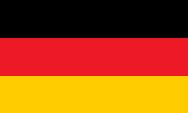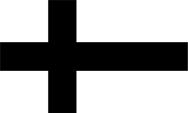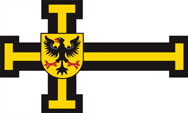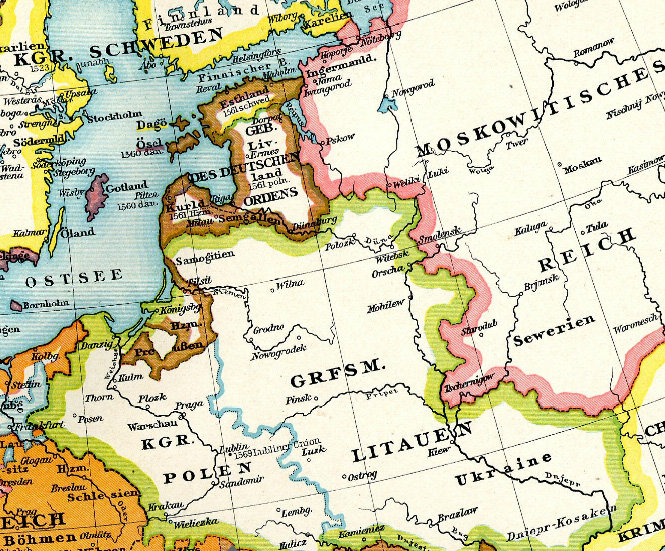mobile View, to the German Version tap the flag


- State of the Teutonic Order (1226–1561)
- Latin name: Ordo fratrum hospitalis Sanctae Mariae Domus Teutonicorum in Jerusalem
- Latin short name: Ordo Teutonicus
- English translation of the name: Order of the Brethren from the Hospital of the Virgin Maria (or hospital of Saint Maria) of the German House in Yerusalem
- Englisch short name: Teutonic Order
- other names for the order:
– Teutonic Knights
– German Masters
– Maria's Knights
• Flags
• Meaning/Origin of the Flag
• Coat of Arms
• Meaning/Origin of the Coat of Arms
• Map
• Numbers and Facts
• History

Flag of the Teutonic Order (Teutonic Knights)




Flag of the High-Master of the Teutonic Order (Teutonic Tnights)




The flag of the Teutonic Order has her origin in the in 1198 this order awarded white robe with a black cross. The robe was corroborated after resistance by the Order of the Temple howewer not until the year 1221 by the pope. The flag of the high-master stylizes the to the Teutonic Order awarded golden cross of Yerusalem, and showes in the middle the coat of arms of the Holy Roman Empire of German Nation. Should the black cross of the Teutonic Order get depicted heraldically correct as "bar cross" (later named "German Cross", too) on a white blazon, then must the width of one crossbar amount 2/7 of the shield's width.
Source: Volker Preuß, Ronald Preuß


Blazon of the Teutonic Order (Teutonic Knights)
Source, by: Wikipedia (D)

The coat of arms of the Teutonic Order has its origin (as with the flag) in the symbolism which was awarded to this order in 1198: the black cross on a white background. Should the black cross of the Teutonic Order get depicted heraldically correct as "bar cross" (later named "German Cross", too) on a white blazon, then must the width of one crossbar amount 2/7 of the shield's width.
Source: Volker Preuß, Ronald Preuß


Source:
F.W.Putzgers Historischer Schul-Atlas
This map shows the State of the Teutonic Order in the 16th cenutry, within a brown border.

Area: 69 730 square miles (16th century)
Inhabitants: in the 16th century there should have been until 1 000 000 inhabitants
Source: Ronald Preuß, Wikipedia (D)

1190 · foundation of the Teutonic Order as a hospital brotherhood near Akko (Palestina)
1198 · conversion into a spiritual order of knights
1225 · duke Conrad of Masovia calls the order for the christianization of the Pruzzes in his land and bequeathes the order the Kulmerland
1226 · bestowing of sovereign rights of the state to the order
1237 · inclusion of the Livonian Brothers of the Sword, takeover of the by this subjected Livland (Livonia)
1267 · conquest of Kurland (Courland)
1283 · conquest of Sudauen
1290 · conquest of Semgallen (Semigallia)
1291 · transfer of the order's seat to Venice (North Italy)
1309 · acquisition of Pommerellen (Pomerelia) and Danzig
1309 · transfer of the order's seat to Marienburg (East Prussia)
1346 · acquisition of North Estonia
1398 · acquisition of Gotland Island
1402 · acquisition of the Brandenburg Neumark
1410 · Battle of Tannenberg
1411 · first Thorn peace treaty, ceding of Samogitia to Lithuania
1440 · formation of the anti clerical Prussian alliance
1454–1466 · fights between Prussian alliance and the order
1457 · transfer of the order's seat to Koenigsberg (East Prussia)
1466 · second Thorn peace treaty, ceding of Kulmerland, Ermland, Pommerellen with Danzig, Elbing and Marienburg to Poland
1525 · secularization of the Prussian territory of the order and conversion in the Duchy of Prussia as a Polish fiefdom by the high-master Albrecht von Brandenburg-Ansbach
1527 · transfer of the order's seat to Mergentheim (Württemberg)
1561 · conversion of Kurland in a Polish fiefdom, ceding of Livland to Poland, ceding of Estonia to Sweden
1809 · dissolution of the order in Germany outside of Austria by Napoléon, transfer of the order's seat to Vienna (Austria)
1929 · conversion into a pure clerical order
today's name:
• Fratres domus hospitalis Sanctae Mariae Teutonicorum in Jerusalem
• Brethren of the German House of Saint Maria in Yerusalem
Source: Volker Preuß, Ronald Preuß,
Wikipedia (D),
Discovery '97


Kindly supported by: Ronald Preuß (D)
![]()









